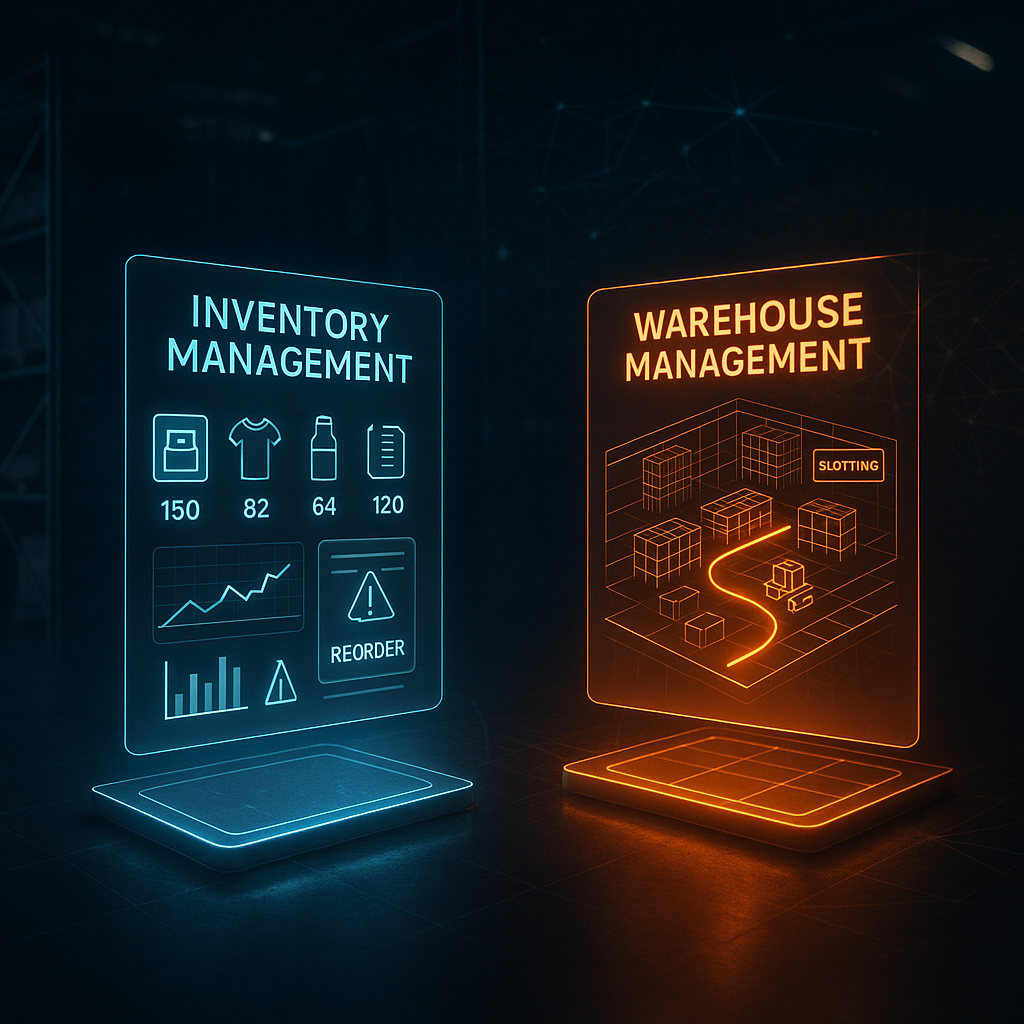How Does a Warehouse Management System Work?
Are you battling frequent stock inaccuracies, late shipments, or labor inefficiency? As of 2024, the global warehouse management system market was...
In the 1990's we started a software company with a team spread-out across the country working remotely. No software solution existed that would allow us to streamline our operations and improve efficiency - so we built our own.
“Working at NEX has been a game-changer for me. I’ve never been part of a team so committed to innovation and collaboration. Every day, I feel like my ideas truly make an impact.”
— Jordan M., Product Manager

Discover how NEX significantly enhanced First Atlantic Commerce's
operations, billing processes, and overall data management efficiency.
6 min read
Sophie Atalla : Oct 9, 2025 1:00:00 PM
Inventory errors are costly. Excess stock inflates storage costs, while stockouts damage your brand and drive customers elsewhere. Despite advances, inventory accuracy for mid-to-large retailers still averages just 70%. In fact, 82% of shoppers have faced out-of-stock items in the past year. (Panorama Consulting)
Fragmented systems silently drain profits—causing delays, overstocking, and missed sales. Integrated inventory management systems can contribute to noticeable improvements in customer satisfaction by reducing errors and delays.
Are you still managing inventory in silos? Or is it time to unify your systems and take control? In this guide, we’ll break down the key benefits of integrated inventory systems and why they’re essential for modern supply chains.
An integrated inventory system connects your inventory data with key enterprise platforms, including ERP, warehouse management, order management, and CRM tools, to create real-time visibility across your entire operation. Instead of relying on disconnected software and manual updates, teams gain a centralized, always-accurate view of stock levels, movements, and availability.
Basic inventory software tracks stock quantities and locations but lacks system-to-system communication. This isolation leads to frequent errors like stockouts, overstocking, and fulfillment delays because inventory data isn’t updated across departments.
Integrated inventory systems fix this by syncing every sale, return, restock, or transfer instantly. This eliminates manual work, increases accuracy, and gives every team access to the same real-time inventory data.
A proper integration connects your inventory with ERP tools like SAP or NetSuite, OMS platforms, warehouse management systems, and CRMs such as Salesforce. When these systems are connected, operations become faster, cleaner, and more reliable.
Sales can see what’s actually available. Warehouses pick from up-to-date stock. Finance tracks inventory value accurately. Every function works off the same data stream.
For enterprise teams, inventory management is about more than just tracking products. It’s about maintaining the right inventory levels to meet demand, without excess. Integration reduces errors, improves inventory turnover, and keeps your supply chain responsive.
With the right system in place, inventory becomes a strategic advantage. Not a constant fire to put out.
When your inventory management system is integrated across your enterprise tech stack, it unlocks real-time visibility, faster operations, and smarter decision-making. Here's how it drives results.
Integrated inventory systems sync stock updates instantly across sales, warehouse, and ERP platforms. This eliminates blind spots and manual reconciliations. Everyone works from the same accurate, real-time inventory data—no delays, no guesswork.
That means fewer stockouts, less excess inventory, and faster order decisions. If you're still wrestling with the basics of inventory visibility, this guide on why inventory matters breaks down its true operational impact.
When inventory is aligned with your order and warehouse management systems, fulfillment becomes a streamlined process. Orders route automatically based on stock location and availability. According to Shopify, businesses often experience fewer returns related to shipping errors when their inventory, order, and warehouse systems are aligned, which is a direct boost to customer satisfaction and operational reliability.
With centralized inventory data, demand forecasting gets sharper. Trends, seasonality, and SKU performance are all visible in one place. You can optimize inventory levels to avoid overstocking while still meeting demand. The result: leaner procurement, less dead stock, and stronger cash flow.
Manual inventory updates slow everything down. Integrated systems automate stock adjustments, restocking alerts, and reporting, removing bottlenecks and human error. Integrated inventory solutions can help warehouses increase order processing efficiency significantly, reducing the need for additional staff. That’s not about adding people. It’s about better systems.
As your business grows, disconnected tools become a liability. Integrated inventory platforms scale with your operations, whether you’re adding new sales channels, warehouses, or SKUs. You maintain control and consistency without adding complexity.
Integrated inventory systems reduce carrying costs, cut waste, and boost inventory value by aligning stock with real demand. The financial gains extend to better asset management and stronger long-term ROI.
Inventory challenges look different across industries, but the need for real-time accuracy, visibility, and control is universal. Whether you're dealing with high-velocity online orders, complex manufacturing processes, or multi-location distribution, an integrated inventory management system adapts to the demands of your operations. Here’s how it delivers measurable impact in three core sectors.
E-commerce businesses depend on accurate, real-time inventory across multiple sales channels. When stock levels aren’t synced instantly between platforms like Shopify, Amazon, and your warehouse, overselling and fulfillment errors are inevitable. Integrated inventory management ensures every sale, return, and restock is reflected system-wide, improving order accuracy, streamlining returns, and reducing customer complaints. For high-volume sellers, it’s the only way to maintain both speed and scale.
In manufacturing, inventory integration is essential to keeping production on schedule. Gaps between systems cause raw material shortages, stalled lines, and production delays.
It syncs data continuously across ERP, warehouse, and production tools, giving teams full visibility into available stock, work-in-progress, and reorder status. This minimizes downtime, supports accurate planning, and ensures production never gets held up by missing parts.
Distributors manage high volumes of inventory across multiple warehouses, often with complex customer contracts and lead times. Without integration, it’s nearly impossible to track stock accurately or optimize fulfillment. An integrated inventory system centralizes data across all locations, enabling smarter order routing, better forecasting, and tighter control over margins. It’s the foundation for maintaining service levels while scaling efficiently.
Most inventory management systems promise efficiency, but few deliver true integration. For enterprise operations, the right system must do more than track stock. It needs to unify inventory data across platforms, support real-time updates, and scale with your business. Learn how NEX Driver's Inventory Management Module enables seamless integration across platforms.
An integrated inventory management system should sync with your ERP, warehouse management software, and order processing tools. If inventory data is not updated instantly across platforms, you risk errors, delays, and poor planning. Cloud-based access is now essential, especially for distributed teams, and your platform should handle different types of inventory while maintaining accurate records at all times.
Full visibility into inventory across all warehouses and channels is no longer optional. If your system cannot track inventory at the item level or support reliable forecasting, it is not built for long-term growth.
When evaluating platforms, ask how inventory integration works in practice. Which systems are supported out of the box? Does the platform support real-time syncing or rely on batch updates? Can you define custom rules for reorder thresholds or routing logic? Push past surface-level demos and look for proof, ideally in the form of case studies from companies in your industry with similar scale and complexity.
A capable system should support open APIs and include built-in connectors for platforms like NetSuite, Salesforce, and Shopify. It must manage inventory data across multiple locations and roles without requiring constant manual intervention. If you cannot automate updates, control inventory levels across your network, or adapt quickly to demand changes, integration will fail to deliver its value.
Integration is not a feature. It is the foundation for better inventory tracking, smarter asset management, and scalable operations.
Rolling out an integrated inventory management system requires more than just plugging in new software. It involves rethinking how you manage inventory, structure workflows, and maintain data accuracy. Here are the most common roadblocks, and how to avoid them.
Legacy inventory systems often contain outdated, duplicated, or inconsistent records. If this data is imported without cleanup, it undermines the entire integration.
Audit and standardize your inventory records before going live. Reconcile stock counts, remove duplicates, and align data formats across systems. Clean data is critical for real-time inventory visibility and accurate reporting from day one.
Even the best inventory management software fails without user adoption. If teams don’t understand how to manage inventory within the new system, errors will creep in.
Focus training on key workflows like automating inventory updates, tracking stock across warehouses, and interpreting real-time dashboards. The goal is not just to use the system, but to use it correctly and consistently.
Large-scale system changes often face internal resistance. To minimize disruption, launch the new inventory management system in one warehouse or business unit at a time. This pilot phase enables teams to adapt, identify integration issues early, and establish internal advocates to support a broader rollout.
Clear communication around the benefits of inventory integration, like better control, reduced stockouts, and streamlined inventory processes, helps build buy-in across departments.
For enterprises managing multiple channels and SKUs, integrated inventory systems are essential, not optional. Without a centralized platform, inventory errors pile up, fulfillment slows down, and decision-making suffers from unreliable data.
The right inventory management system doesn’t just streamline operations. It gives you control, clarity, and room to scale. It aligns your teams, automates critical workflows, and ensures you always have the right inventory in the right place at the right time.
Ready to take the next step? Explore our inventory management solutions and see how integrated systems can improve accuracy, efficiency, and control across your entire supply chain.

Are you battling frequent stock inaccuracies, late shipments, or labor inefficiency? As of 2024, the global warehouse management system market was...
-1.png)
Recent trends highlight that a reliable Order Management System (OMS) is essential for navigating the complexities of modern marketplaces. Consider a...

5 min read
Choosing between inventory and warehouse management systems is overwhelming—especially for SMBs managing tight budgets. According to McKinsey,